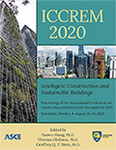International Conference on Construction and Real Estate Management 2020
Neighboring Behavior and Social Adaptation of Low-Income Groups: The Mediating Role of Mental Health
Publication: ICCREM 2020: Intelligent Construction and Sustainable Buildings
ABSTRACT
We examine the effects of neighboring behavior on the social adaptation of low-income Chinese employees. We further examine the mediating role of mental health in this relationship. To conduct a thorough examination, the neighboring behavior scales, the 12-item general health questionnaire (GHQ-12), and the social adaptation self-evaluation scale were presented to 241 low-income residents in a mixed-income community. Structural equation modeling (SEM) was adopted to evaluate data from a two-wave survey conducted in China. The findings of this study indicate that, for low-income groups, neighboring behavior has an effect on social adaptation, and the effect is partially mediated by mental health. Our research expands the scope of current community support literature by incorporating bi-directional neighboring behavior. By adopting mental health as a mediator, our findings examine the spillover mechanisms through which social adaptation and mental health are influenced by neighboring behavior. This study also provides suggestions on how low-income groups in mixed-income communities can improve their social adaptation.
Get full access to this article
View all available purchase options and get full access to this chapter.
REFERENCES
Berking, M., Orth, U., Wupperman, P., Meier, L.L. and Caspar, F. (2008). “Prospective effects of emotion-regulation skills on emotional adjustment.” Journal of Counseling Psychology, 55(4), 485-494.
Bolino, M.C. and Grant, A.M. (2016). “The bright side of being prosocial at work, and the dark side, too: a review and agenda for research on other-oriented motives, behavior, and impact in organizations.”Academy of Management Annals, 10(1), 599-670.
Bosc, M., Dubini, A. and Polin, V. (1997). “Development and validation of a social functioning scale, the Social Adaptation Self-evaluation Scale.” European Neuropsychopharmacology, 57-70.
Brislin, R.W. (1970). “Back-translation for cross-cultural research.” J Cross Cult Psychol, 1(3), 185-216.
Cobb, S. (1976). “Social support as a moderator of life stress.” Psychosomatic Medicine, 38(5), 300-314.
Cohen, S. and Wills, T.A. (1985). “Stress, social support, and the buffering hypothesis.” Psychological Bulletin, 98(2), 310-357.
Cropanzano, R. and Mitchell, M.S. (2005). “Social exchange theory: an interdisciplinary review.” Journal of Managemen, 31(6), 874-900.
Gao, F., Luo, L. and Thumboo, J. (2004). “Does the 12-item general health questionnaire contain multiple factors and do we need them?” Health and Quality of Life Outcomes, 2(1), 63.
Goldberg, D.P. and Hillier, V.F. (1979). “A scaled version of the general health questionnaire.” Psychological Medicine, 2, 9.
Griggs, T.L., Casper, W.J. and Eby, L.T. (2012). “Work, family and community support as predictors of work–family conflict: a study of low-income workers.” Journal of Vocational Behavior, 82(1), 59-68.
Haber, M.G., Cohen, J.L., Lucas, T. and Baltes, B.B. (2007). “The relationship between self-reported received and perceived social support: a meta-analytic review.” American Journal of Community Psychology, 39(1-2), 133-144.
Holden, L., Lee, C., Hockey, R., Ware, R.S. and Dobson, A.J. (2015). “Longitudinal analysis of relationships between social support and general health in an Australian population cohort of young women.” Quality of Life Research, 24(2), 485-492.
Jackson, Y. and Warren, J.S. (2000). “Appraisal, social support, and life events: predicting outcome behavior in school-age children.” Child Development, 71(5), 1441-1457.
Kawachi, I. and Berkman, L.F. (2001). “Social ties and mental health.” Journal of Urban Health, 78(3), 458-467.
LePine, M.A., Zhang, Y., Crawford, E.R. and Rich, B.L. (2016). “Turning their pain to gain: charismatic leader influence on follower stress appraisal and job performance.” Academy of Management Journal, 59(3), 1036-1059.
Li, X.W. (2002). “Different adaptive pupils’ self-description and evaluation: a research on the mechanism of self-regulation.” Journal of psychological science, 02(8), 156-160.
Mehmood, Q., Hamstra, M.R., Nawab, S. and Vriend, T. (2016). “Authentic leadership and followers’ in-role and extra-role performance: The mediating role of followers’ learning goal orientation.” Journal of Occupational and Organizational Psychology, 89(4), 877-883.
Perkins, D.D., Florin, P., Rich, R.C., Wandersman, A. and Chavis, D.M. (1990). “Participation and the social and physical environment of residential blocks: crime and community context.” American Journal of Community Psychology, 18(1), 83-115.
Shumaker, S.A. and Brownell, A. (2010). “Toward a theory of social support: closing conceptual gaps. Journal of Social Issues, 40(4), 11-36.
Stevens, J.P. (2009). “Applied multivariate statistics for the social sciences.” Journal of the Royal Statistical Society, 43(1), 219.
Wen, Z.L., Hau, K. and Chang, L. (2005). “A comparison of moderator and their applications.” Acta Psychologica Sinica, 37(2), 268-274.
Werner-Seidler, A., Afzali, M.H., Chapman, C., Sunderland, M. and Slade, T. (2017). “The relationship between social support networks and depression in the 2007 National Survey of Mental Health and Well-being.” Soc Psychiatry Psychiatr Epidemiol, 52(12), 1463-1473.
Williamson, H.C., Altman, N., Hsueh, J. and Bradbury, T.N. (2016). “Effects of relationship education on couple communication and satisfaction: A randomized controlled trial with low-income couples.” J Consult Clin Psychol, 84(2), 156-166.
Windle, M. (1992). “A longitudinal study of stress buffering for adolescent problem behaviors.” Developmental Psychology, 28(3), 522-530.
Information & Authors
Information
Published In
ICCREM 2020: Intelligent Construction and Sustainable Buildings
Pages: 815 - 823
Editors: Yaowu Wang, Ph.D., Harbin Institute of Technology, Thomas Olofsson, Ph.D., Luleå University of Technology, and Geoffrey Q. P. Shen, Ph.D., Hong Kong Polytechnic University
ISBN (Online): 978-0-7844-8323-7
Copyright
© 2020 American Society of Civil Engineers.
History
Published online: Oct 14, 2020
Published in print: Oct 14, 2020
Authors
Metrics & Citations
Metrics
Citations
Download citation
If you have the appropriate software installed, you can download article citation data to the citation manager of your choice. Simply select your manager software from the list below and click Download.
